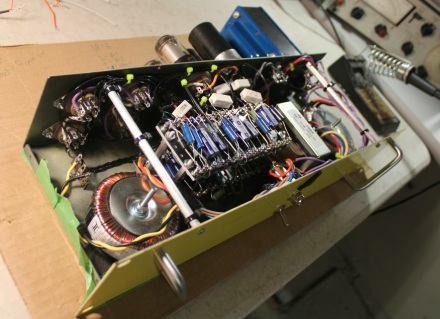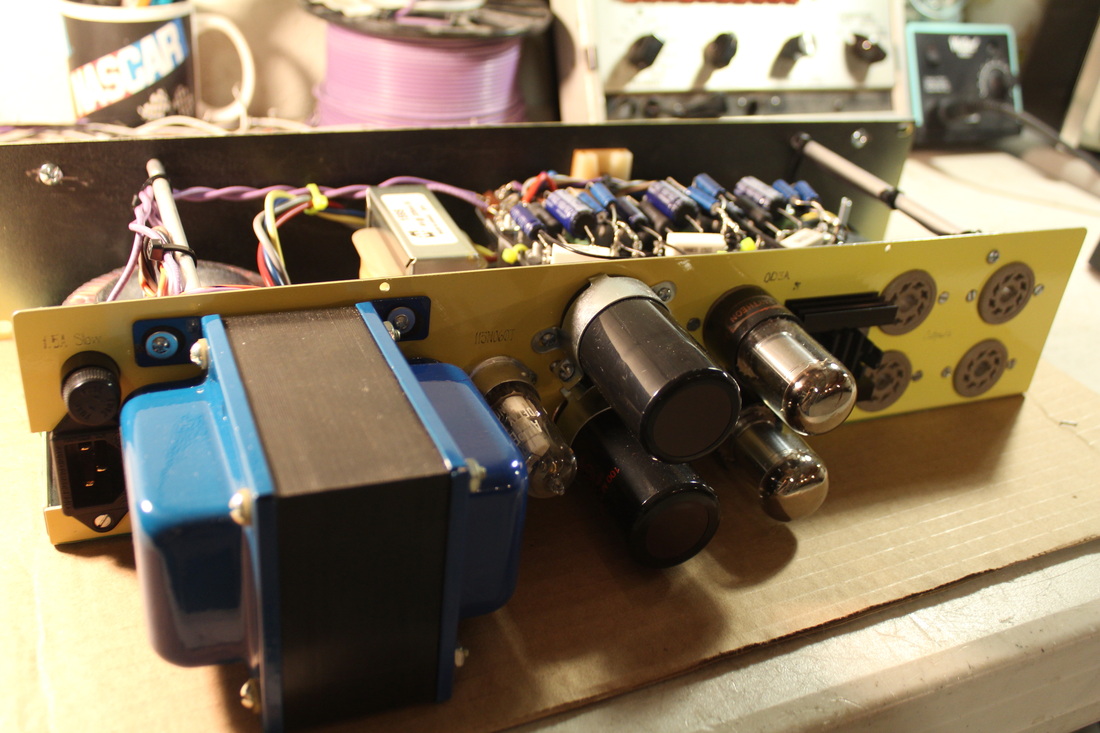|
11/29/2015 Moving forward with Trinity... LBA's most significant product under development.Read Now Joe Griffin, of Bamboo Room Studio in Kentucky, funded the construction of the first production prototype of Trinity. That unit (#002) is a stereo version which now lives and works at the Bamboo Room. Joe and the Bamboo crew were so impressed by Trinity they had to have more. About a week ago Joe placed another order, but this time its a bit different. I decided to make some changes for the better in terms of the layout and component quality in both the power supply and Trinity. The biggest difference is now the power supply is much bigger (2U rack mount) and Trinity is mono and a single rack space. The power supply can power up to 4 channels of Trinity. Joe wanted 4 more channels of Trinity, so his order is for the new Beast Mode II power supply and 4 mono Trinity channel strips. When completed, the Bamboo Room will have six channels of Lightning Boy Audio Trinity channel strips, more than even LBA Studios has (at the moment). As the first person outside of Lightning Boy Audio to hear Trinity, this is what Joe had to say: Everyone here agrees; myself, Jeff, and Dennis...Trinity is the best preamp in the studio. Incredibly flexible... we see many uses for it. Vocals were incredible through an SM57, a mic we always use for reference. Bass DI is the best we have ever heard. Going to experiment with rooms/drums tonight. How long would it take to get another one? Number them 3 and 4!! Okay, that's good news. lol. I then asked Joe if he had the chance to play around with the EQ on Trinity at all. Here's what he had to say about that: Love it in and out. With it in, the bass frequencies can be pushed beyond... dial in the treble... awesomeness! All good feedback and I really appreciate Joe's support for the development of Trinity. When the job is done I'll update the Trinity page, but the product still won't be released. I have to first built a 4 channel Trinity system for Lightning Boy Audio to keep. That setup is in the financial funding stage (almost there!) and when its complete a lot of photos, videos, and reviews will have to happen in order to release the product. We're getting closer to an actual product release, but its still a ways off. Meanwhile, I will continue to accept orders for pre-release Trinity channel strips and I'll give you a super sweet deal!
Beast Mode IIJust wrapping up with the first Beast Mode II Power Supply Unit. No expense has been spared in creating this. It is the biggest, most badass power supply I have ever created. It has been said that bigger is not necessarily better. However, in this particular situation bigger is absolutely better. The Beast Mode II has been designed to supply ultra low noise, high current power to four Trinity channel strips. It has separate power transformers for the B+ power, phantom power, and tube filament supplies. The big blue transformer supplies the B+ and also has a 6v tapoff, which powers the LED circuitry. Inside is a massive power filter choke, a pair of low noise toroidal transformers, and the electronics necessary for regulation of each power supply within the Beast Mode II. On the back side can be seen the can caps, a thermal relay tube, a pair of voltage regulator tubes, the heatsink associated with the tube filament regulator supply, and the octal power sockets used to connect power to each channel of Trinity. Its definitely a strange hybrid, but it performs unbelievably well. Silicon diodes were used for all power rectification (B+, filament supply, phantom power, LED power supply). A very expensive military-grade solid-state voltage regulator is used to perfectly regulate the DC voltage for the vacuum tube heater filaments in order to achieve supremely low noise. The square black heatsink can be seen on the back side of the Beast Mode II. The two large vacuum tubes on the back are actually not vacuum tubes. They are filled with Xenon gas and are used to regulate the B+ voltage - in conjunction with capacitors & a filter choke. The resulting B+ power is perfectly free from ripple or voltage swing. The small tube on the back is actually a thermal relay vacuum tube. It controls an automated start up sequence that's much like a standby switch on a guitar amp. This standby switch automatically flips on 60 seconds after the power switch is turned on. The phantom power section offers a dedicated power supply for each channel, with each one being regulated to provide up to 2 amps of direct current at exactly 46.6 volts. The LED power section is the only non-regulated supply in the Beast Mode II. It provides 4 amps (way overkill) of direct current at 6 volts to power the LED lights on each connected channel of Trinity.
Outputs (via rear panel octal sockets):
My work of Art is not ready for the public yet. It needs to be 100% problem free, perfect in every way, and rock solid for life. Its pretty much that already, but its now a matter of fine tuning. I decided to go with some Texas Instruments regulators for the DC filament supply. These puppies are over $50 each for American-made quality vs. the $5 chinese knockoffs I used during prototyping. I figure the American stuff will probably last longer even though their technical specifications are the same. I also decided to change the power supply tether design to something safer, more robust, and unfortunately more expensive. I'm leaving the 5-pin XLR connector design and moving on to the bigger, more powerful 8-pin octal tube socket connectors... similar to the connections you would find on a vintage Wurlitzer electric piano or maybe some hammond organ stuff. Big cables with big connectors. The connectors and cabling are 3x's the price, but Trinity is destined for greatness and no parts skimping can be a part of that. I decided to go with a bigger, more power PSU which will be able to power 4 channels of Trinity. From extensive testing I have determined Trinity needs to be a mono unit, not stereo. This will ensure perfect isolation from cross talk between multiple channels.
As you can see, a lot has been going on in the further development of the product. Its going to be a major player for LBA, so there is no point in rushing to meet a deadline on this one. Its done when its done. |
Details
About the AuthorMike Congilosi II, Owner/Designer/Electronics Engineer at Lightning Boy Audio and Owner/Audio Engineer/Music Producer at LBA Studios. Archives
July 2025
Categories |

 RSS Feed
RSS Feed

